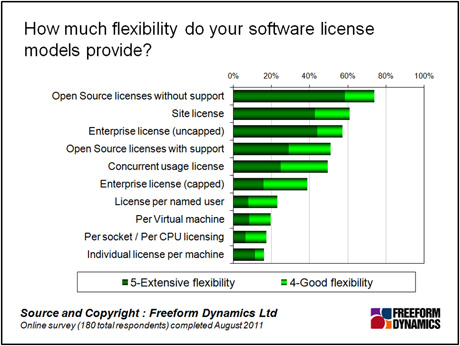A few months ago we highlighted the difficulties that many companies have when it comes to managing software licences and subscriptions.
One of the issues raised was that in an age where almost all the talk from IT vendors is of moving towards a dynamic infrastructure based on virtualisation or cloud computing, the complexity and variety of approaches can make licence management difficult to understand and master.
This in turn tends to make it very difficult to simply ramp services up or down as needed, hampering the ability to provide dynamic IT services effectively and legally.
So just how much of a problem is this in reality?
We recently revisited this area by running a survey to see how well suited current licensing practices are suited to dynamic IT infrastructures.
When asked whether the licensing terms that are on offer from vendors restrict the ability of the business to run IT services based on virtual infrastructure or private cloud type technologies, only around a quarter of respondents thought that licensing terms do not really restrict the use of dynamic infrastructure.
Around 40 per cent of respondents thought that licensing hampered flexibility in some instances, while almost a third said that it’s a problem in the majority of cases.
This is a fairly damning indictment of the current state of affairs.
To see why current licensing practices have such a negative impact on service flexibility, it’s helpful to look at the different licence types and to examine how flexible they are perceived to be.
There is a wide gulf in flexibility between the different licence types.
It’s clear that licence types that are measured in terms of defined entities such as server, CPU socket or user are perceived as being very restrictive.
This is the case even for the modern equivalent that charges per virtual machine.
These types of licences worked in the age of static workloads and dedicated machines, but are becoming archaic in the face of virtualised and dynamic services.

On the other hand, licensing is seen to give a lot more freedom when it moves to a model where there is flexibility to choose how to use it, either up to an agreed cap or through an unlimited licence.
When we look at how widespread the use of these licence types are, we see that there is a major difference in use as companies grow.
The smaller businesses that responded to the survey tend to use the pay-per-something model to a much larger degree, and do not make nearly as much use of enterprise or site licences.
Smaller business may be caught in a trap of licence inflexibility, but there is an escape route employed.
Small businesses are very likely to make use of open-source software.
However, there is a wake up call for open-source vendors in that this is much more likely to be an unsupported implementation, indicating that the support models for open-source getting complex or expensive.
Larger enterprises tend to make extensive use of all types of licence today, and in particular site and concurrent user licences, which they have the scale and negotiating power to purchase.
This adds complexity and mixes up the environment, making it difficult to create uniform or end-to-end services.
If you are looking to move more and more workloads to a virtualised on-demand environment, it will be crucial to the long-term success and economics of the initiative to make sure that the licensing models you employ follow the same path.
Above all, it’s time to start moving away from the pay-per-something licence wherever possible as this will tie you into a corner with not much room to manoeuvre as requirements change.
CLICK HERE TO VIEW ORIGINAL PUBLISHED ON

Content Contributors: Andrew Buss
Through our research and insights, we help bridge the gap between technology buyers and sellers.





Have You Read This?
From Barcode Scanning to Smart Data Capture
Beyond the Barcode: Smart Data Capture
The Evolving Role of Converged Infrastructure in Modern IT
Evaluating the Potential of Hyper-Converged Storage
Kubernetes as an enterprise multi-cloud enabler
A CX perspective on the Contact Centre
Automation of SAP Master Data Management
Tackling the software skills crunch